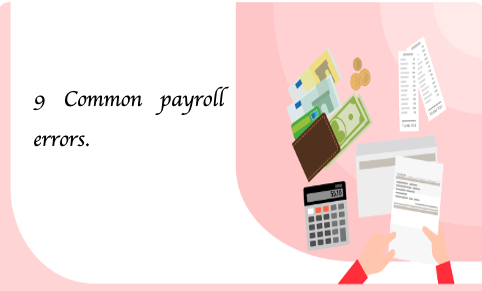9 Common Payroll errors.
Payroll errors occur when a payroll software does not do what is expected to be done based on its features. The responsibilities of the payroll system are very crucial in the organization.
The most important feature is when your payroll system performs accurate work because any slight error may lead to fines or other penalties. If you cannot choose the best payroll software provider, you may incur most payroll errors.
Payroll errors exist in the real business cycle. For example, in 2022, reports emerged that employees of grocery chain Asda were taking loans, skipping bill payments, and using food banks because a payroll provider made more than 10,000 errors, affective more than 5,000 people.
Furthermore, an article published by the Sunday Times revealed that thousands of employees of fashion and homeware retailers were underpaid after a new payroll system was implemented.
The article added that employees’ pension contribution was deducted without being invested in their retirement funds.
It is important to note that effective payroll management requires a payroll system that allows all employees to receive payments, on time and in compliance with applicable laws.
Therefore, without the right payroll software tools, employee payroll can be a minefield for errors that could cost the organization and lead to employees’ frustration.
How payroll errors impact your business.
–Losing experts
Payroll plays an important role in maintaining highly qualified employees. Most employees depend on the salary earned from their hard work. In the case of payroll errors, these employees will lose trust in the company and start looking for more liable companies.
However, a one-off error might be ignored but when an error is repeated several times, the company will experience financial problems leading to employees’ frustration and end up leaving the company.
–Poor company reputation.
Company reputation is very important. Before, an employee seeks a job from any company, they have to check the company’s reviews. Suppose the reputations are bad, the company might not receive experienced and competent employees.
Company reputation also affects customers and investors who might be willing to purchase or invest in the company’s goods and services.
If employees, investors, or customers realise that the company always makes payment errors that affect its payment disbursements, they will look for better companies and the company will struggle to attract them.
–Increase costs.
Payroll errors will make your employees leave your company especially if this happens repeatedly. In this case, the company will have to recruit other employees who might not be easy to get due to poor company reputation.
This means you will have to increase the cost of recruiting and training the new workforce.
Therefore, the company’s budget will be affected because they will have to spend more money due to high turnover.
The other cost that the company may incur due to payroll errors is penalties. Late payments of wages and taxes will attract penalties which can be costly.
–Time wastage.
Payroll errors can be more than 10,000 in one payment schedule. Fixing all these errors requires more than 24 hours. When more time is used to fix these errors, more payment delays are made which attract other expenses such as fines and penalties.
Also, payment delays frustrate employees and this might lead to poor production.
-Increase money concerns for employees.
Paying employees, the expected amount is one motivating factor. When employees receive an unexpected amount, they get demoralized leading to poor working motives.
Payroll errors may involve underpayment, incorrect deductions, overpayment, and missing payments among others. If employees are more concerned about delayed payment, they will not work effectively.
Common payroll errors.
1.Misclassification of employees.
Misclassification of employees occurs when a payroll system incorrectly determines the types of employees based on payment. This error leads to incorrect pay, ultimately leading to underpayment or overpayment of wages.
The most common misclassification error is making an incorrect determination on whether an employee should fall under exempt or non-exempt. According to the Fair Labor Standards Act, all employees must receive overtime pay unless they are classified as exempt.
Therefore, when payroll software classifies a non-exempt employee as exempt, it does not only open your company to FLSA-related fines but also causes employees to miss their overtime earnings.
Also, a misclassification error occurs when an individual is classified as an independent contractor instead of an employee. This error results in having the whole payroll system scrutinized and making retroactive payments or other changes to employee pay.
The company can lose a lot of money from this error if not early detected.
2.Miscalculation of payments.
Employees expect payments to be done in an accurate way depending on the work done. When these payments are incorrect, most employees get frustrated especially if the error results in missed payments.
In addition, this error could take more than 24 hours to fix and this requires more hours of work from the payment team. The employees may end up not paying their bills on time.
Some of the common miscalculation scenarios include the following:
- Underpaying or overpaying employees.
- Missing the first payment for new employees.
- Deducting the wrong amount for benefits or other payroll deductions.
- Making erroneous retroactive payments.
- Improperly paying employees who are on non-paid leave.
3.Not tracking employees’ hours and overtime.
Employees work extra hours to increase their earnings. When payroll software fails to track overtime hours, many employees will miss the extra payment.
Depending on the amount the employee earns, this error may not be easily detected leading to corrections that might take over a year.
Since the corrections are time-consuming, both the company and the employees will suffer from losses, especially underpaid employees. Overtime payment errors can occur if a payment is missed in any of the following scenarios:
- When employees are engaged in other activities such as training during a normal working hour.
- When employees are working during break times.
- When employees spent time traveling between work sites.
4.Incorrect Tax forms.
In most cases, your employees will use their W-2 and any other company-issued tax form to pay their income taxes.
When an error is made in one of these forms, problems may arise for both the company and employees.
The employee payment report not only comprises salary, overtime, commissions, or bonuses but also taxable compensation. For example, the employee may receive deductions from the following;
Rewards
- Stock options and equity award.
- Personal use of company car.
If one of the above deductions is not accurately included in the payroll, both employees will fall under late tax filing penalties
5.Disorganised or incomplete records.
Some of the information in a payroll system is done by a human. With the large volume of files and data, some information may be missing or an error may occur during the process of feeding data to the software.
Disorganized records may lead to miss-payment or lead to more time taken to follow up on items that require urgent attention.
In addition, having a manual system for managing payroll increase your chance of reliance on a person’s accuracy to manage all payroll actions.
Without automated and organized payroll software, it will be difficult for someone to fill the software with the correct information leading to more problems during audit or process review.
6.Not tracking important deadlines.
Payment deadlines are meant to be followed strictly. Employees expect their payments on time. If the payroll system does not track payment deadlines, some employees may miss the pay at their hour of need.
This leads to frustration and some may fail to pay their bills. Also, this error may cause the company to experience tax delays which will expose them to penalties and fines.
7.Not updating tax rates.
In most countries, tax rates are subject to change and if the company does not update these changes on time, it will be penalized and imposed to fine.
The payroll software should be able to update these taxes to avoid any anomalies.
Tax rate updates may also affect the employees’ payments especially when a wrong tax deduction is made. Incorrect payment will bring frustration to the employees and even lose loyalty to the organization.
8.Incorrect payroll frequency.
When employees are hired, a payroll manager will set a pay frequency. The frequency can be daily, weekly, monthly, or semimonthly. The federal government does not have set rules on how frequently you should pay your employees.
However, there are state pay frequency requirements and any incorrect payroll frequency can result in penalties or fines to your company. Failure to follow payment frequency could result in losing the trust of your employees.
9.Not considering holidays.
If the organization pays on a fixed schedule, some payments may fall on a bank holiday at some point. This will delay payments for employees by at least a day. Though this might not be a serious issue some employees will find it unfair and lose work morale.
A payroll software might count holidays as normal working days and increase payment to employees based on days worked. This will result in overpayment and make it hard for the company to recover or fix the problem.
How to avoid payroll errors.
–Conduct an audit.
A full payroll software audit is very important. Regular reviews can be enough to prevent payroll errors. However, some errors may be fundamental in their source. Carrying regular audits will help you assess your current process and identify any loopholes.
You will have to assess your human resources and payroll software systems so that you can identify any inaccurate elements. Therefore, conducting an audit may be enough to find the cause of payroll errors.
–Establish clear policies on the payroll.
A clear guideline describing all the processes on your payroll activities will help reduce payroll errors. This also includes a policy for records management and retention. Doing this helps you to comply with a legal requirement to keep payroll records for up to three years according to FLSA.
-Using a six-part economic realities test.
The use of the department of labor’s six-part economic realities test will help you determine if a new worker is an independent contractor or an employee. You can also file a Form SS-8 to determine the worker status for federal employment taxes and income tax withholding. This procedure will help you mitigate the misclassification of employees’ errors.
-Evaluate your payroll provider.
A review of your payroll provider gives insight into what their customers say about their services. If your organization is experiencing frequent errors, this might be the time to check your payroll provider.
You may also need to consider changing your payroll providers. When selecting a payroll provider, you can check on their payroll features so as you identify those that align with your goals.
-Automate and integrate payroll process.
An integrated payroll system helps you automate payroll workflows. This will avoid manual entries and time-consuming processes that can more likely result in errors.
Also, payroll automation helps you keep track of employees’ hours, deadlines, and scheduling among others. This helps you avoid employee underpayment or overpayment errors. In most cases, this idea helps you to achieve the following;
- Have a system that records employees’ hours and calculates their overtime payments.
- Have a system that aligns actual employees’ pay with the HR actions such as salary adjustments and bonus awards.
- Having a system that consolidates reports that help you view and manage the workforce at a glance and in real-time.
-Review Fair labor standard act guidelines on employee exemption.
A careful review of the above act helps you identify several guidelines. According to the act, an employee is only exempt if
- You pay them a salary
- You pay them a minimum of $35,568 per year or $685 per week
- When an employee has executive, administrative or professional job duties that directly affect the business operations.
Every State may have strict guidelines on who may or may not be considered exempt.
-Check emails concerning tax rate updates.
Since some States will send you a notice of each year’s tax rate to your company email, it is important to regularly check these updates along with employment tax rates.
Some payroll software has an online tax rate monitor enabled. It is important to also consider this feature when choosing your payroll provider.
-Check your state payroll frequency law.
Checking your state payroll frequency law will help solve incorrect payroll frequency errors. You may do this by having a separate pay frequency platform depending on employees’ working hours.
Remember to separate the employees and pay them according to the schedule. You may also set a reminder for when to run a payroll and when to pay on time.
How to fix payroll errors.
- Identify the source of error and find a solution for preventing it from your payroll provider or payroll manager.
- Cancel the payroll, amend the error and run it again.
- Be transparent about the nature of the error to your employees and stakeholders.
- Run the reports to keep track of the amendment and keep the records of your payroll errors.
- Train your employees to make use of the payroll software especially when they want to verify their information, and update their clock in and clock out.
- Notify relevant parties such as government agencies depending on the nature of the error by sending a payroll processing error letter and also do the same to the affected employees.







